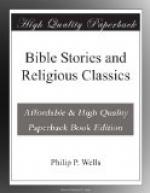If any of my young friends ask why I have read this long-time-ago Bible-story as a text for a sermon to-day, I will not only answer, but thank them for the question; for nothing helps a speaker at the start so much as a straight, intelligent question. I have read this story from the Chronicles, because I want to connect this beautiful occasion with some beautiful thing in the Bible; for beautiful things go together.
My main object and desire in this service is to have everything beautiful and pure and high. For I know how well you will remember this day in after years; I know how every feature and incident is imprinting itself upon your minds; I know how, twenty and forty years hence, when we older ones will be dead and gone, and you will be scattered far and wide, some in the great cities—New York, Chicago, St. Louis—some in California, and some further off still—I know how, on quiet June Sundays years hence, you will recall this Festival of Flowers in North Adams. You may be in some of the great cities, or on the broad prairies, or among the park-like forests of the Sierra, or in Puget Sound, but you will never forget this day. These familiar walls; this pulpit and font and chancel decked with flowers; this service, made for you and in part by you—you will never forget it. And because you will always remember it, I want to have it throughout just as beautiful, just as pure and inspiring, as possible. The flowers will do their part; they never fail to speak sweet, pure words to us. Your Superintendent always does his part well, and I hope you will all thank him in your hearts, if not in words, for his faithful and laborious interest in you. And your teachers and others who have brought together this wealth of beauty, this glory of color and perfume, this tribute of sweetness from mountain-side and field and garden—they have done well; and you will remember it all years hence, and when far away, and perhaps some tears will start for “the days that are no more.”
But this occasion would not be complete to my mind if there were not linked with it some noble and inspiring trutn. I want to make all these flowers and this music the setting of a truth, like a diamond set round with emeralds, or an opal with pearls. You have brought the pearls and the emeralds; I must bring a diamond or an opal to set in the midst of them. I am very sure that I have one in this old story—a diamond very brilliant if we brush away the old Hebrew dust, and cut away the sides and let in a little more light upon it. I am not sure, however, but I ought to call it a pearl rather than a diamond; for there is a chaste and gentle modesty about it that reminds one of the soft lustre of a pearl rather than of the flashing splendor of a diamond. St. John, in naming the precious stones that make the foundation of the heavenly city, omits the diamond—and for some good reason, I suspect—while the twelve gates were all pearls. Now, I think David stood very near one of those gates of pearl at the time of this story. To my mind, it is nearly the most beautiful in all this Book; and I know you will listen while I tell it more fully.




